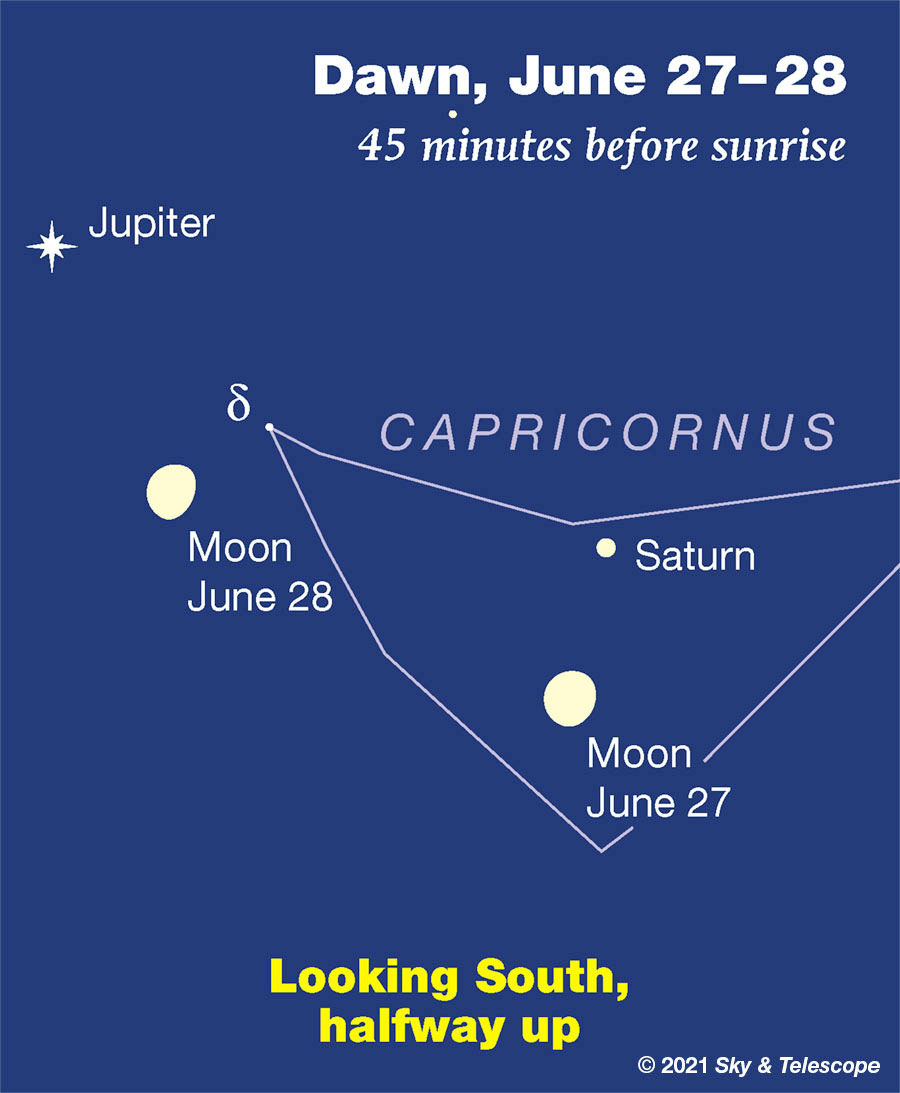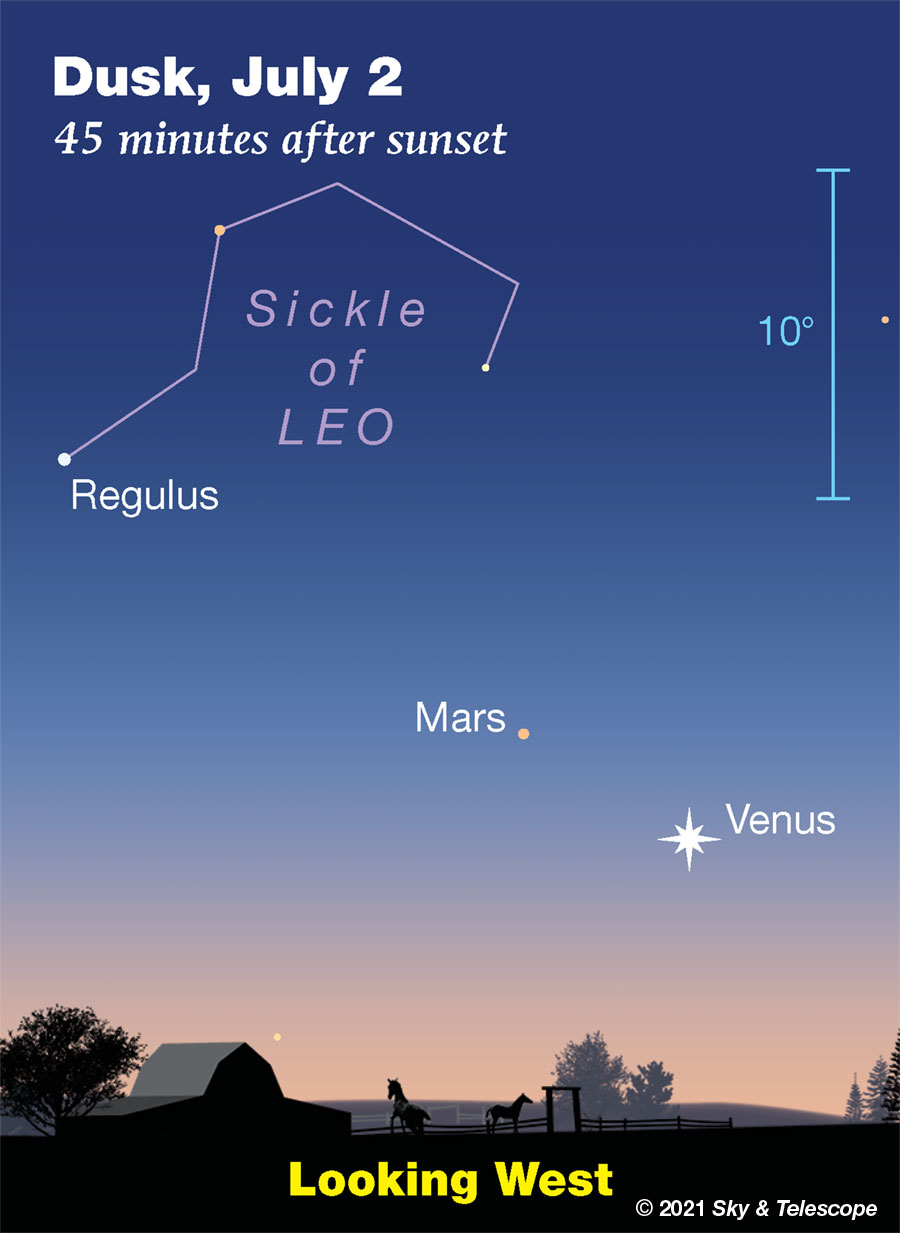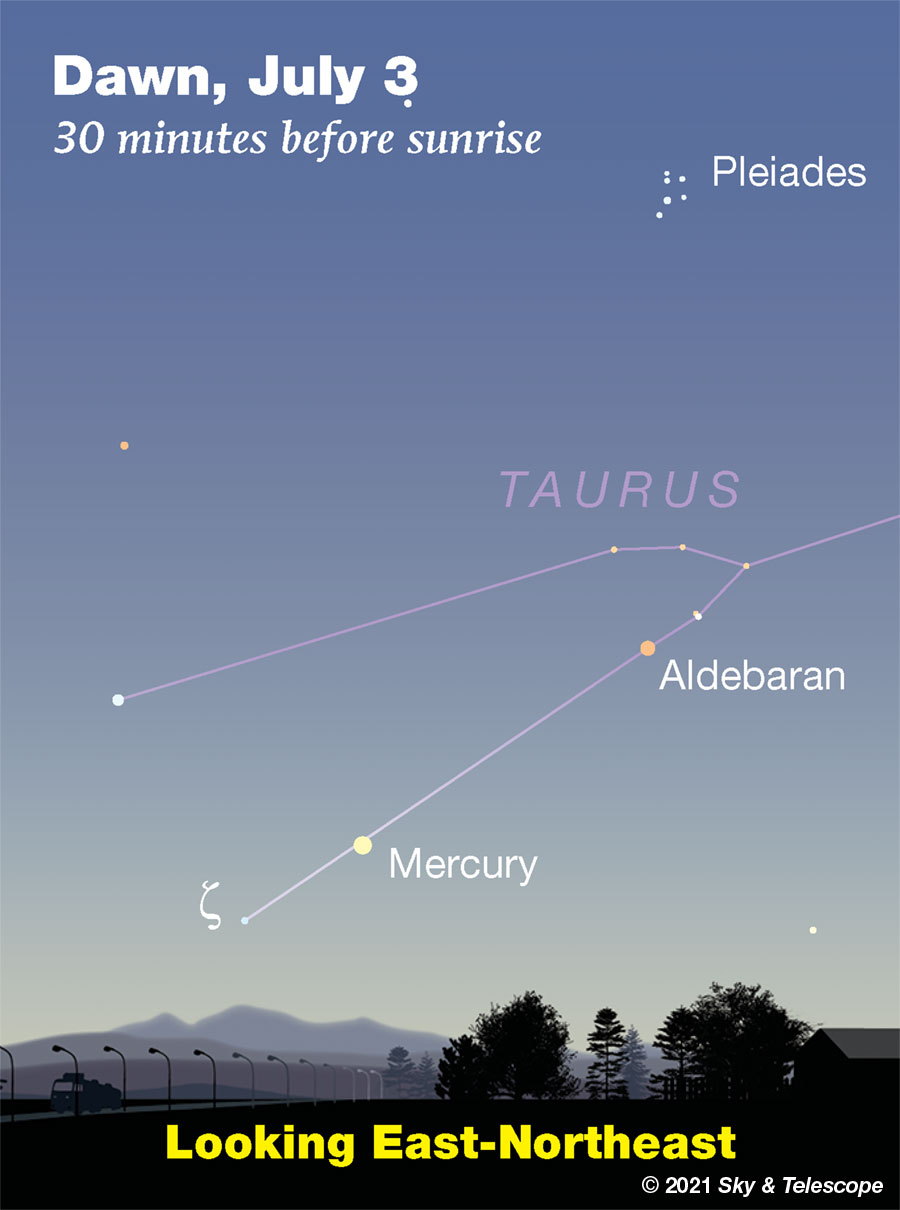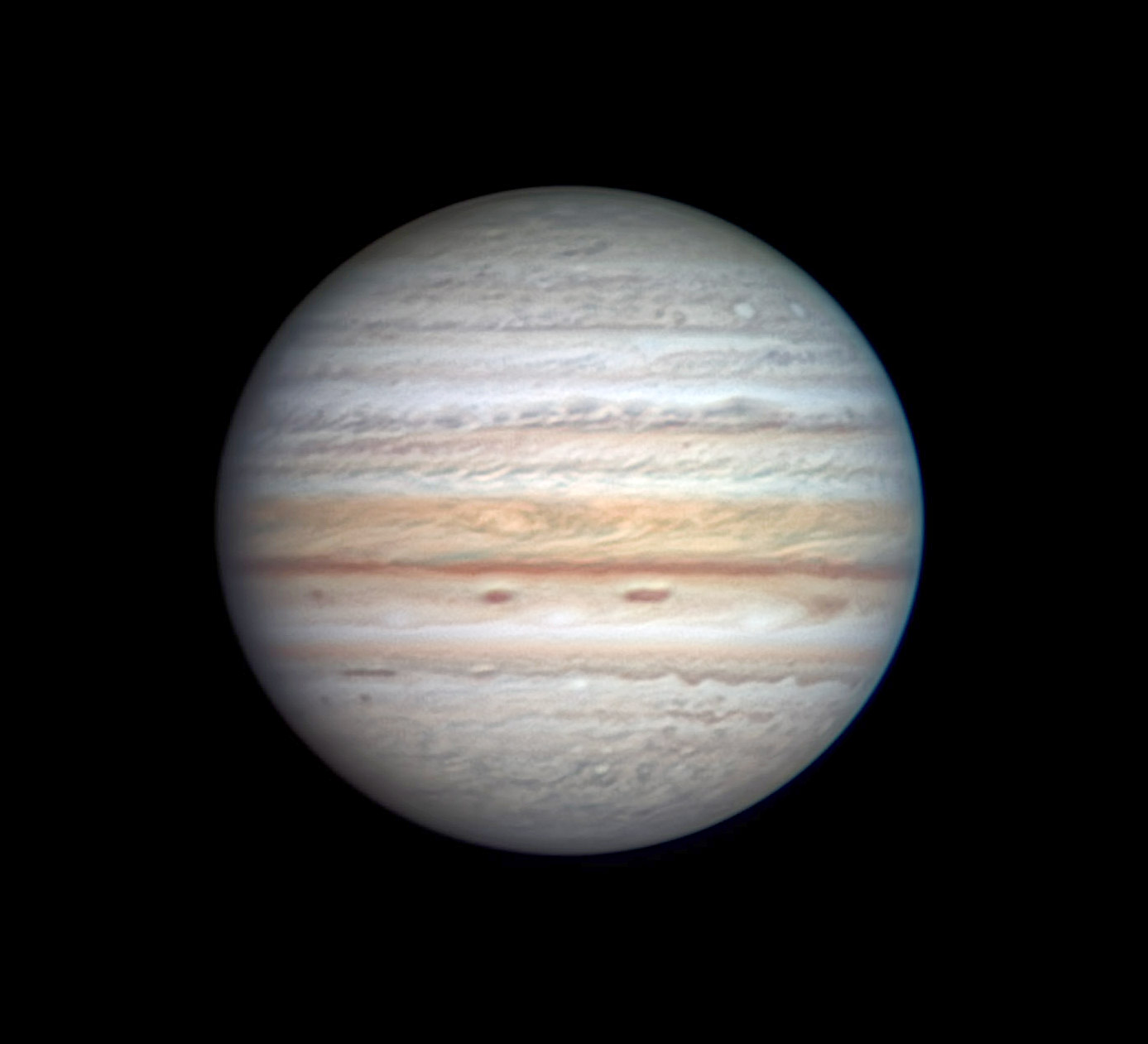Nova Cassiopeiae goes wobbly. It's been 3½ months since Nova Cas 2021 erupted on March 19th to magnitude 7.7. Surprisingly, it has stayed roughly that bright ever since — except for swelling to 5.3, faint naked-eye visibility, for a week in May before dropping back to about 7.7. It's been wavering slightly since then. As of June 29th it was 6.8.
The nova is moderately low in the north-northeast after dark depending on your latitude. It climbs higher later in the night. Charts and comparison stars.
...But not Nova Herculis. This one leapt up to 6.3 on June 12th and faded fast. As of June 24th it was down to 11.8 visually. See Bright Nova in Hercules on a Roller Coaster Ride.
FRIDAY, JUNE 25
■ Leo is mostly a constellation of late winter and spring. But he's not gone yet. As twilight ends look due west, somewhat low, for Regulus, the Lion's brightest and now lowest star: the forefoot of his stick figure. You'll find Regulus upper left of Venus and Mars.
The Sickle of Leo extends upper right from Regulus, by about a fist at arm's length. The rest of the Lion's constellation figure runs upper left from there for a couple of fists, to his tail star Denebola, the highest. Leo will soon tread offstage into the sunset.
SATURDAY, JUNE 26
■ On the eastern side of the sky, the big Summer Triangle holds sway after dark. Its top star is Vega, the brightest in all the east. The brightest star to Vega's lower left is Deneb. Farther to Vega's lower right is Altair.
■ Look south in early dawn on Sunday morning the 27th, and there's Saturn over the waning gibbous Moon, as shown below. Jupiter watches from their upper left.

SUNDAY, JUNE 27
■ Star colors are mostly subtle, and different people have an easier or harder time seeing them. To me, the tints of bright stars show a little better on a late-twilight sky background than in a fully dark sky.
For instance, the two brightest stars of summer are Vega, high in the east in late twilight, and Arcturus, even higher in the southwest. Vega is white with just a touch of icy blue. Arcturus is a yellow-orange giant. Do their colors stand out a little better for you in late twilight than in dark night?
Binoculars, of course, always make star colors much easier.
■ The waning gibbous Moon rises in late evening. Once it's up, look for Jupiter to its left and dimmer Saturn to its upper right.
By dawn on Monday morning the 28th, this Jupiter-Moon-Saturn arrangement is higher and rotated clockwise as shown above.
MONDAY, JUNE 28
■ After nightfall, look for the Big Dipper hanging straight down high in the northwest. Its bottom two stars, the Pointers, point lower right toward modest Polaris, the end of the Little Dipper's handle.
Examine the middle star of the Big Dipper's handle, Mizar. Can you see its faint little companion Alcor nestled next to it? It's just upper right of Mizar — pointing, as always, in the direction from Mizar to Vega.
TUESDAY, JUNE 29
■ This is the time of year when, after dark, the dim Little Dipper floats straight upward from Polaris — like a helium balloon on a string, escaped from some summer-evening party. Through light pollution, however, all you may see of the Little Dipper are Polaris at its bottom and Kochab, the lip of the Little Dipper's bowl, at the top.
WEDNESDAY, JUNE 30
■ Now that July is about to arrive, Antares and the starry head of Scorpius are at their highest in the south shortly after the long summer twilights finally give up the ghost.
The "head of Scorpius" is the near-vertical row of three stars upper right of Antares. Three fine doubles await you here. The top star of the row is Beta Scorpii or Graffias, a fine binary for telescopes, separation 13 arcseconds, magnitudes 2.8 and 5.0.
Just 1° below it is the very wide naked-eye pair Omega1 and Omega2 Scorpii, diagonal from upper right to lower left. They're 4th magnitude and ¼° apart. Binoculars show their slight color difference; they're spectral types B9 and G2.
Upper left of Beta by 1.6° is Nu Scorpii, separation 41 arcseconds, magnitudes 3.8 and 6.5. In fact this is a telescopic triple. High power in good seeing reveals Nu's brighter component itself to be a close double, separation 2 arcseconds, magnitudes 4.0 and 5.3, aligned almost north-south.
■ And more: In the same binocular field with Antares, or nearly so, are two very different globular star clusters for binoculars. M4 is a big, dim fuzzy relatively nearby for a globular. M80 is fainter and much more compact, even tiny; in fact it can be hard to distinguish in binoculars from an 8th-magnitude star. It's a bigger and denser cluster than M4 but more than four times as far away. Use the chart for them with Matt Wedel's Binocular Highlight column in the July Sky & Telescope, page 43.
THURSDAY, JULY 1
■ Last-quarter Moon (exact at 5:11 p.m. EDT). The Moon rises around 1 a.m. tonight daylight-saving time, shining at the Cetus-Pisces border.
Any time from then until early dawn, look high above the Moon for the Great Square of Pegasus standing on one corner.
FRIDAY, JULY 2
■ Venus shines low in the west-northwest during twilight, with vastly fainter Mars now just 6° to its upper left. They set before twilight's end.
Venus hardly moves now with respect to your landscape from week to week, but its background stars are sliding right along, toward the lower right. On July 2nd the Beehive Cluster, M44, passes behind Venus. Try binoculars or a wide-field scope — but this will be a difficult observation if it's possible at all! You'll have to catch the narrow time window between the sky being too bright and Venus and the Beehive getting too low and setting. That window may or may not exist, depending on your optics, the sharpness of your eyes for faint stars in twilight, and the clarity of the air.


SATURDAY, JULY 3
■ Low in the northwest or north at the end of these long summer twilights, would you recognize noctilucent clouds if you saw them? They're the most astronomical of all cloud types, what with their extreme altitude and formation on meteoric dust particles. And they're fairly rare — though they've become more common in recent years as the atmosphere and climate change. See Bob King's Nights of Noctilucent Clouds.
This Week's Planet Roundup
Mercury glimmers very faintly very low in the east-northeast as dawn grows bright. If you want to try for it with binoculars or, better, a wide-field telescope, don't confuse it with twinklier Aldebaran to its upper right. See the illustration above.
Venus (magnitude –3.8) shines low in the west-northwest during twilight. Tiny Mars, nearly 200 times fainter at magnitude +1.8, is closing in on Venus from the upper left. They're separated by 10° on June 25th, shrinking to 6° by July 2nd. Both set before twilight ends. They'll be in conjunction, ½° apart, on July 12th and 13th.
Venus hardly moves now with respect to your landscape from week to week, but the background stars move right along. On July 2nd the Beehive Cluster, M44, slides behind Venus. You can try for the brightest Beehive stars with binoculars or a wide-field scope, but this will be a difficult observation if it's possible at all. You'll need to catch the narrow time window between when the sky is too bright and the Venus-Beehive combo gets too low and sets. That window may not exist if the air isn't super-clear.
Jupiter and Saturn (in Aquarius and Capricornus, respectively) rise in late evening: first Saturn, then brighter Jupiter about an hour later. They shine at their highest and telescopic best in the south before dawn. Jupiter dominates at magnitude –2.6. Saturn, 20° to Jupiter's west (right), is a more modest +0.4. They'll reach their oppositions in August.
Before dawn, look 20° below or lower left Jupiter for Fomalhaut. It forms a fairly good isosceles right triangle with Jupiter and Saturn. Jupiter is at the (almost) right angle.

Uranus (magnitude 5.8, in Aries) is low in the east before dawn begins.
Neptune (magnitude 7.9, in Aquarius 21° east of Jupiter) is well up in the southeast before dawn.
All descriptions that relate to your horizon — including the words up, down, right, and left — are written for the world's mid-northern latitudes. Descriptions that also depend on longitude (mainly Moon positions) are for North America.
Eastern Daylight Time, EDT, is Universal Time minus 4 hours. Universal Time is also known as UT, UTC, GMT, or Z time. To become more expert about time systems than 99% of the people you'll ever meet, see our compact article Time and the Amateur Astronomer.
Want to become a better astronomer? Learn your way around the constellations. They're the key to locating everything fainter and deeper to hunt with binoculars or a telescope.
This is an outdoor nature hobby. For an easy-to-use constellation guide covering the whole evening sky, use the big monthly map in the center of each issue of Sky & Telescope, the essential magazine of astronomy.
Once you get a telescope, to put it to good use you'll need a detailed, large-scale sky atlas (set of charts). The basic standard is the Pocket Sky Atlas (in either the original or Jumbo Edition), which shows stars to magnitude 7.6.

Next up is the larger and deeper Sky Atlas 2000.0, plotting stars to magnitude 8.5; nearly three times as many. The next up, once you know your way around, are the even larger Interstellarum atlas (stars to magnitude 9.5) or Uranometria 2000.0 (stars to magnitude 9.75). And be sure to read how to use sky charts with a telescope.
You'll also want a good deep-sky guidebook, such as Sky Atlas 2000.0 Companion by Strong and Sinnott, or the bigger (and illustrated) Night Sky Observer's Guide by Kepple and Sanner.
Can a computerized telescope replace charts? Not for beginners, I don't think, and not on mounts and tripods that are less than top-quality mechanically, meaning heavy and expensive. And as Terence Dickinson and Alan Dyer say in their Backyard Astronomer's Guide, "A full appreciation of the universe cannot come without developing the skills to find things in the sky and understanding how the sky works. This knowledge comes only by spending time under the stars with star maps in hand."
![]() Audio sky tour. Out under the evening sky with your
Audio sky tour. Out under the evening sky with your
earbuds in place, listen to Kelly Beatty's monthly
podcast tour of the heavens above. It's free.
"The dangers of not thinking clearly are much greater now than ever before. It's not that there's something new in our way of thinking, it's that credulous and confused thinking can be much more lethal in ways it was never before."
— Carl Sagan, 1996
"Facts are stubborn things."
— John Adams, 1770
 3
3









Comments
Rod
June 29, 2021 at 7:24 am
mary beth, New Jersey Eclipse Fan. I enjoyed some excellent Moon, Jupiter, and Saturn observing early today. Here is a note from my stargazing long. I used the 90-mm refractor telescope. [Observed 0215-0415 EDT/0615-0815 UT. Last Quarter Moon 01-July-2021 2111 UT. Enjoyable views this morning of the waning gibbous Moon, Jupiter, and Saturn. Using 14-mm with 1.8x Barlow lens, excellent views of Saturn, rings, Cassini division, some cloud bands at 129x. Titan and Rhea moons visible along with some other fainter stars in the 8th to 10.5 apparent magnitude range. I switched to 40-mm plossl for 25x views. Saturn lovely with faint stars all around. While I observed Saturn at low power, wide field view, an equatorial satellite passed by near Saturn's position in the sky. The satellite perhaps 4th or 5th apparent magnitude. Saturn retrograde in Capricornus, moving farther away in angular separation from Theta Capricorni star. The moonlight was bright and ethereal all over the pastures, fields, and woods. An owl was hooting at times. At Jupiter, I used #58 Green filter at 129x views. The Great Red Spot crossed central meridian of Jupiter 0827 UT this morning so I could see the Great Red Spot. Many cloud bands visible on Jupiter. I enjoyed views of the Moon too at 129x and 25x using the 40-mm plossl with Moon filter. At 25x, I could see the Moon and Tau Aquarii star in the FOV, ~ 45 arcminute angular separation from the Moon. Numerous craters visible along the terminator line. Temperature 23C with light winds from SSW but humidity near 95%. While daytime temperatures were 32C, the early morning observations of Jupiter and Saturn using my 90-mm refractor were exceptional and excellent. Saturn transit this morning my location near 0337 EDT/0737 UT.]
You must be logged in to post a comment.
mary beth
June 30, 2021 at 11:29 am
Nice report Rod! It sounds like you have a very good understanding of the science of the lenses and filters. That alone must’ve taken a while to perfect. Lots of clouds here but we get occasional glimpses of all the main stars and Venus. Dumb question but will Jupiter snd Saturn be a lot brighter when they are at opposition in August? I assume so but I know they’re more involved than that.
You must be logged in to post a comment.
Rod
June 30, 2021 at 11:57 am
mary beth, yes is the answer for Jupiter and Saturn at opposition. You can see this using Stellarium or the monthly Sky & Telescope magazines. Each month has a Planetary Almanac and shows apparent magnitude changes and angular size changes visible in telescopes. I have tracked these changes and documented in my stargazing log at home 🙂
You must be logged in to post a comment.
You must be logged in to post a comment.